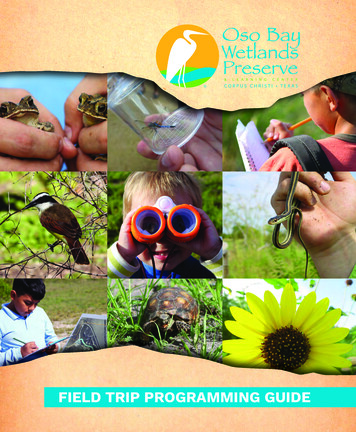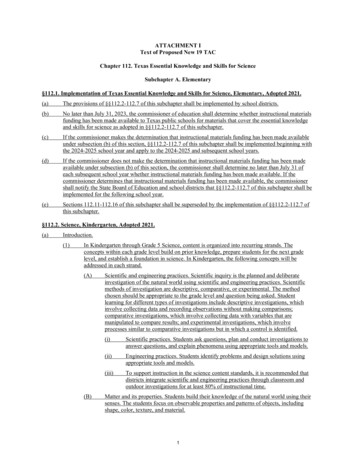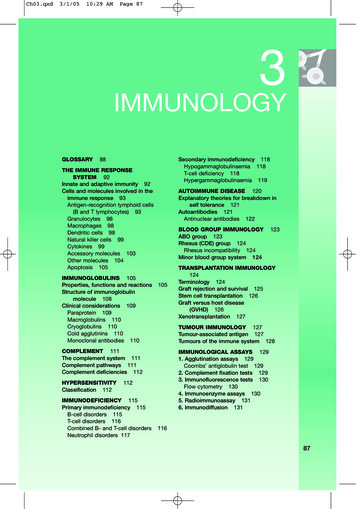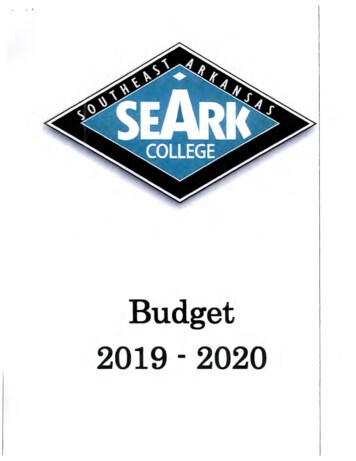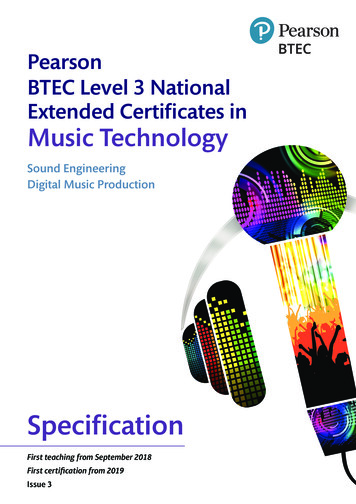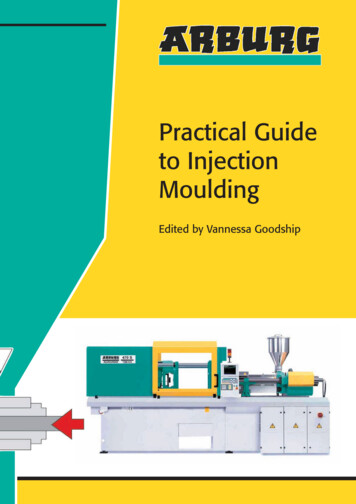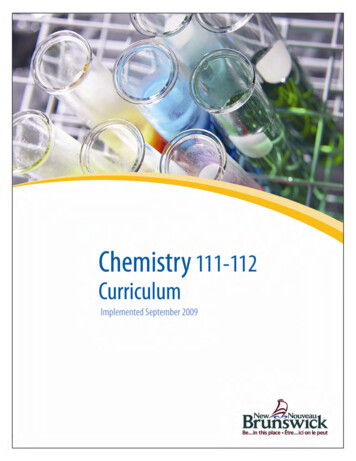
Transcription
Chemistry 111 – 112 Curriculum Guide
2009Department of EducationEducational Programs and Services BranchAdditional copies of this document may be obtained using the Title Code 8444402Chemistry 111 – 112 Curriculum
AcknowledgementsUnder the Atlantic Provinces Education Foundation (APEF) common curriculum agreement, theprovince of Nova Scotia was the lead province in the development of the high school ChemistryCurriculum guide for the Atlantic Provinces. The Department of Education of New Brunswick gratefullyacknowledges the contributions of the members of the local and regional chemistry committees in theAtlantic Provinces for their professional expertise and insights in developing these guides. We alsoacknowledge the contribution of the PEI Department of Education who have also made availablesupporting laboratory guides for the use of NB teachers. Special thanks go to the following people whowere involved in the revisions and development of the New Brunswick guides as members of the NBHigh School Science Curriculum Development Advisory committee, or as piloting teachers:3Vicki AtkinsonTeacher, Kennebecasis Valley High School, QuispamsisMyra BeckettTeacher, Rothesay High School, RothesayAlexis ChristmasTeacher, Fredericton High School, FrederictonKim CrippsTeacher, Miramichi Valley High School, MiramichiPaul DunnettTeacher, Kennebecasis High School, QuispamsisAnne FurlotteTeacher, Bathurst High School, BathurstKris GallagherTeacher, Southern Victoria High School, Perth-AndoverVance JessomeTeacher, Chipman Forest Avenue School, ChipmanPaul KettelaTeacher, Woodstock High School, WoodstockJonathan LoganTeacher, Sir James Dunn Academy, St. AndrewsMartha McClureNew Brunswick Department of Education, FrederictonChris MclaughlinTeacher, Southern Victoria High School, Perth-AndoverDebby PeckPhD Candidate, Science Education, UNB, FrederictonMichael SwiftTeacher, Sussex Regional High School, SussexNancy VessieTeacher, Miramichi Valley High School, MiramichiChemistry 111 – 112 Curriculum
4Chemistry 111 – 112 Curriculum
Part 1 The Teaching FrameworkChemistry 111 – 112CurriculumPart 1The Teaching Framework5Chemistry 111 – 112 Curriculum
Part 1 The Teaching Framework6Chemistry 111 – 112 Curriculum
Part 1 The Teaching FrameworkTable of ContentsIntroduction . .9Background 9Rationale.9Program Design & Components . .10Learning and Teaching Science . . 10The Three Processes of Scientific Literacy . 11Meeting the Needs of All Learners . .12Assessment and Evaluation . .12Outcomes . . 14Outcomes Framework 14Curriculum Guide Organization .15Unit Organization . . . .15Unit Overview . . . .17Attitude Outcomes . . . .197Chemistry 111 – 112 Curriculum
Part 1 The Teaching Framework8Chemistry 111 – 112 Curriculum
Part 1 The Teaching FrameworkIntroductionBackgroundThe curriculum described in Foundation for the Atlantic CanadaScience Curriculum was planned and developed collaborativelyby regional committees. The process for developing thecommon science curriculum for Atlantic Canada involvedregional consultation with the stakeholders in the educationsystem in each Atlantic province. The Atlantic Canada sciencecurriculum is consistent with the science framework described inthe pan-Canadian Common Framework of Science LearningOutcomes K to 12.The development of these curricula involved further revision ofthe Atlantic Canada Science Curriculum for Chemistry 11 andChemistry 12, in consultation with educators in New Brunswickover a 3-year period (as listed in the Acknowledgements).RationaleThe aim of science education in the Atlantic provinces is todevelop scientific literacy.Scientific literacy is an evolving combination of the sciencerelated attitudes, skills, and knowledge students need todevelop inquiry, problem-solving, and decision-making abilities;to become life-long learners; and to maintain a sense of wonderabout the world around them. To develop scientific literacy,students require diverse learning experiences which provideopportunity to explore, analyze, evaluate, synthesize,appreciate, and understand the interrelationships amongscience, technology, society, and the environment that will affecttheir personal lives, their careers, and their future.9Chemistry 111 – 112 Curriculum
Part 1 The Teaching FrameworkProgram Design & ComponentsLearning and TeachingScienceWhat students learn is fundamentally connected to how they learn it.The aim of scientific literacy for all has created a need for new forms ofclassroom organization, communication, and instructional strategies.The teacher is a facilitator of learning whose major tasks include: creating a classroom environment to support the learning andteaching of science designing effective learning experiences that help studentsachieve designated outcomes stimulating and managing classroom discourse in support ofstudent learning learning about and then using students‟ motivations, interests,abilities, and learning styles to improve learning and teaching analyzing student learning, the scientific tasks and activitiesinvolved, and the learning environment to make ongoinginstructional decisions selecting teaching strategies from a wide repertoireEffective science learning and teaching take place in a variety ofsituations. Instructional settings and strategies should create anenvironment which reflects a constructive, active view of the learningprocess. Learning occurs not by passive absorption, but rather asstudents actively construct their own meaning and assimilate newinformation to develop new understanding.The development of scientific literacy in students is a function of thekinds of tasks they engage in, the discourse in which they participate,and the settings in which these activities occur. Students‟ dispositiontowards science is also shaped by these factors. Consequently, theaim of developing scientific literacy requires careful attention to all ofthese facets of curriculum.Learning experiences in science education should vary and includeopportunities for group and individual work, discussion among studentsas well as between teacher and students, and hands-on/minds-onactivities that allow students to construct and evaluate explanations forthe phenomena under investigation. Such investigations and theevaluation of the evidence accumulated, provide opportunities forstudents to develop their understanding of the nature of science andthe nature and status of scientific knowledge.10 Chemistry 111 – 112 Curriculum
Part 1 The Teaching FrameworkThe Three Processes ofScientific LiteracyInquiryAn individual can be considered scientifically literate whenhe/she is familiar with, and able to engage in, three processes:inquiry, problem solving, and decision making.Scientific inquiry involves posing questions and developingexplanations for phenomena. While there is general agreementthat there is no such thing as the scientific method, studentsrequire certain skills to participate in the activities of science.Skills such as questioning, observing, inferring, predicting,measuring, hypothesizing, classifying, designing experiments,collecting data, analyzing data, and interpreting data arefundamental to engaging in science. These activities providestudents opportunity to understand and practice the process oftheory development in science and the nature of science.Problem SolvingThe process of problem solving involves seeking solutions tohuman problems. It consists of the proposing, creating, andtesting of prototypes, products and techniques in an attempt toreach an optimum solution to a given problem.Decision MakingThe process of decision making involves determining what we,as citizens, should do in a particular context or in response to agiven situation. Decision-making situations are not onlyimportant in their own right. They also provide a relevantcontext for engaging in scientific inquiry and/or problem solving.11 Chemistry 111 – 112 Curriculum
Part 1 The Teaching FrameworkMeeting the Needs of AllLearnersFoundation for the Atlantic Canada Science Curriculum stresses theneed to design and implement a science curriculum that providesequal opportunities for all students according to their abilities, needsand interests. Teachers must be aware of and make adaptations toaccommodate the diverse range of learners in their class. In order toadapt to the needs of all learners, teachers must create opportunitiesthat would permit students to have their learning styles addressed.As well, teachers must not only remain aware of and avoid gender andcultural biases in their teaching, they must strive to actively addresscultural and gender stereotyping regarding interest and success inscience and mathematics. Research supports the position that whenscience curriculum is made personally meaningful, and socially andculturally relevant, it is more engaging for groups traditionally underrepresented in science, and indeed, for all students.When making instructional decisions, teachers must considerindividuals‟ learning needs, preferences and strengths, and theabilities, experiences, interests, and values that learners bring to theclassroom. Ideally, every student should find his/her learningopportunities maximized in the science classroom.While this curriculum guide presents specific outcomes for each unit, itmust be acknowledged that students will progress at different rates.Teachers should provide materials and strategies that accommodatestudent diversity, and validate students when they achieve theoutcomes to the maximum of their abilities.It is important that teachers articulate high expectations for all studentsand ensure that all students have equitable opportunities to experiencesuccess as they work toward the achievement of designatedoutcomes. A teacher should adapt classroom organization, teachingstrategies, assessment practices, time, and learning resources toaddress students‟ needs and build on their strengths. The variety oflearning experiences described in this guide provides access for awide range of learners. Similarly, the suggestions for a variety ofassessment practices provide multiple ways for learners todemonstrate their achievements.Assessment andEvaluationThe terms assessment and evaluation are often used interchangeably,but they refer to quite different processes. Science curriculumdocuments developed in the Atlantic region use these terms for theprocesses described below.Assessment is the systematic process of gathering information onstudent learning.Evaluation is the process of analyzing, reflecting upon, andsummarizing assessment information, and making judgments ordecisions based upon the information gathered.The assessment process provides the data and the evaluation processbrings meaning to the data. Together, these processes improveteaching and learning. If we are to encourage enjoyment in learningfor students, now and throughout their lives, we must develop12 Chemistry 111 – 112 Curriculum
Part 1 The Teaching Frameworkstrategies to involve students in assessment and evaluation at alllevels. When students are aware of the outcomes for which they areresponsible, and the criteria by which their work will be assessed orevaluated, they can make informed decisions about the most effectiveways to demonstrate their learning.Regional curriculum in science suggests experiences that supportlearning within STSE, skills, knowledge and attitudes. It also reflectsthe three major processes of science learning: inquiry, problem solvingand decision making. When assessing student progress it is helpful toknow some activities/skills/actions that are associated with eachprocess of science learning. Examples of these are illustrated in thefollowing lists. Student learning may be described in terms of ability toperform these tasks.Inquiry Problem Solving Decision Making 13 Chemistry 111 – 112 Curriculumdefine questions related to a topicrefine descriptors/factors that focus practical and theoreticalresearchselect an appropriate way to find informationmake direct observationsperform experiments, record and interpret data, and drawconclusionsdesign an experiment which tests relationships and variableswrite lab reports that meet a variety of needs (limit theproduction of “formal” reports) and place emphasis onrecorded datarecognize that both quality of both the process and theproduct are importantclearly define a problemproduce a range of potential solutions for the problemappreciate that several solutions should be consideredplan and design a product or device intended to solve aproblemconstruct a variety of acceptable prototypes, pilot test,evaluate and refine to meet a needpresent the refined process/product/device and support whyit is “preferred”recognize that both quality of both the process and theproduct are importantgather information from a variety of sourcesevaluate the validity of the information sourceevaluate which information is relevantidentify the different perspectives that influence a decisionpresent information in a balanced manneruse information to support a given perspectiverecommend a decision and provide supporting evidencecommunicate a decision and provide a “best” solution
Part 1 The Teaching FrameworkOutcomesOutcomes FrameworkThe science curriculum is based on an outcomes framework thatincludes statements of essential graduation learnings, generalcurriculum outcomes, key-stage curriculum outcomes, and specificcurriculum outcomes. The general, key-stage, and specific curriculumoutcomes reflect the pan-Canadian Common Framework of ScienceLearning Outcomes K to 12. The conceptual map shown in Figure 1provides the blueprint of the outcomes framework.FIGURE 1Essential GraduationLearningsA Vision for ScientificLiteracy in Atlantic CanadaFour ciation of scienceNature of science andtechnologyInitiating and planningRelationship betweenscience and technologyAnalyzing and interpretingSocial and environmentalcontexts of science andtechnologyKNOWLEDGEPerforming and recordingCommunication and teamworkLife sciencePhysical scienceInterest in scienceScience inquiryCollaborationEarth and space scienceStewardshipSafetyKey-stage Curriculum OutcomesSpecific Curriculum OutcomesThis curriculum guide outlines grade level specific curriculum outcomes, and provides suggestions forlearning, teaching, assessment and resources to support students‟ achievement of these outcomes.Teachers should consult the Foundation for the Atlantic Canada Science Curriculum for descriptions ofthe essential graduation learnings, vision for scientific literacy, general curriculum outcomes, and keystage curriculum outcomes.14 Chemistry 111 – 112 Curriculum
Part 1 The Teaching FrameworkCurriculum GuideOrganizationSpecific curriculum outcome statements describe what students shouldknow and be able to do at each grade level. They are intended to serve asthe focus for the design of learning experiences and assessment tasks.Specific curriculum outcomes represent a reasonable framework forassisting students to achieve the key-stage, the general curriculumoutcomes, and ultimately the essential graduation learnings.Specific curriculum outcomes are organized in two to four units for eachgrade level. Each unit is organized by topic. Suggestions for learning,teaching, assessment, and resources are provided to support studentachievement of the outcomes.The order in which the units of a grade appear in the guide is meant tosuggest a sequence. In some cases the rationale for the recommendedsequence is related to the conceptual flow across the year. That is, oneunit may introduce a concept which is then extended in a subsequent unit.Likewise, it is possible that one unit focuses on a skill or context which willthen be built upon later in the year.It is also possible that units or certain aspects of units can be combined orintegrated. This is one way of assisting students as they attempt to makeconnections across topics in science or between science and the real world.Extended time frames may be needed to collect data over time. Thesecases may warrant starting the activity prior to the unit in which it will beused. In all cases logical situations and contexts should be taken intoconsideration when these types of decisions are made.The intent is to provide opportunities for students to deal with scienceconcepts and scientific issues in personally meaningful, and socially andculturally, relevant contexts.Unit OrganizationAll units comprise a two-page layout of four columns as illustrated in Figure2. Each unit is comprised of outcomes grouped by a topic which isindicated at the top of the left page.Column One:Essential LearningOutcomesThe first column lists a group of NB prescribed outcomes thatrelate to the pan-Canadian Specific Curriculum Outcomes listed atthe beginning of each unit. These are based on the pan-CanadianCommon Framework of Science Learning Outcomes K to 12. Thiscolumn also includes appropriate extensions for those studentsenrolled in Chemistry 111 or Chemistry 121. The statementsinvolve the Science-Technology-Society-Environment (STSE), skills,and knowledge outcomes indicated by the outcome number(s) thatappears in brackets after the outcome statement.Curriculum outcomes for each unit have been grouped by topic.Other groupings of outcomes are possible and in some cases maybe necessary in order to take advantage of local situations. Thegrouping of outcomes provides a suggested teaching sequence.Teachers may prefer to plan their own teaching sequence to meetthe learning needs of their students.15 Chemistry 111 – 112 Curriculum
Part 1 The Teaching FrameworkColumn Two:ElaborationsThe second column includes Elaborations of the outcomes, as wellas background information These Elaborations explain further thedepth of understanding that students should acquire. Also includedin this column are Teaching Suggestions, and Optional extensionsof the topic. The suggestions in this column are intended to providea holistic approach to instruction. In some cases, the suggestions inthis column address a single outcome; in other cases, they addressa group of outcomes.Column Three:Tasks for Instruction and/orAssessmentThe third column provides suggestions for ways that students‟achievement of the outcomes could be taught and assessed. Thesesuggestions reflect a variety of assessment techniques whichinclude, but are not limited to, informal/formal observation,performance, journals, interview, paper and pencil, presentations,and portfolio. Some assessment tasks may be used to assessstudent learning in relation to a single outcome, others to assessstudent learning in relation to several outcomes. The assessmentitem identifies the outcome(s) addressed by the outcome number inbrackets after the item.Column Four:NotesThis column will refer teachers to the supporting text and ancillaryresources. For current useful websites, and shared teacherresources, teachers are directed to the NB government TeacherPortal at: https://portal.nbed.nb.ca/FIGURE 2Curriculum Outcomes Organization:The Four-Column, Two-Page SpreadTopicNB PrescribedOutcomes Outcomes based onPan-CanadianSpecific LearningOutcomes Additional outcomesfor Level 1 courseElaborationsElaborations ofoutcomes listed incolumn oneTeaching Suggestions Optional outcomesto be completed aftercompletion of aboveoutcomes16 Chemistry 111 – 112 CurriculumTasks for Instructionand/or rnalInterviewPaper and PencilPresentationPortfolioNotesReferences toprescribed text andsupporting resources.References toAppendices.
Part 1 The Teaching FrameworkUnit OverviewAt the beginning of each unit, there is a two-page synopsis. On the firstpage, introductory paragraphs give a unit overview. These are followedby a section that specifies the focus (inquiry, problem solving, and/ordecision making) and possible contexts for the unit. Finally, acurriculum links paragraph specifies how this unit relates to scienceconcepts and skills that will be addressed at later grades so teacherswill understand how the unit fits with the students‟ progress through thecomplete science program.The second page of the two-page overview provides a table of theoutcomes from the Common Framework of Science LearningOutcomes K to 12 that will be addressed in the unit. The numberingsystem used is the one followed in the pan-Canadian document:100s - Science-Technology-Society-Environment (STSE) outcomes200s - Skills outcomes300s - Knowledge outcomes400s- Attitude outcomes (see pages 10-18)These code numbers appear in brackets after each specific curriculumoutcome (SCO).FIGURE 3Unit OverviewUnit Title: Unit OverviewIntroductionSynopsis of the unitFocus and ContextsFocus: Inquiry, DecisionMaking, or ProblemSolving. Possible contextssuggestedCurriculum LinksLinks to concepts studiedwithin the K-12 sciencecurriculum17 Chemistry 111 – 112 CurriculumUnit Title: Pan Canadian Specific CurriculumOutcomesSTSE### Science –Technology– Society -Environmentoutcomes from CommonFramework of ScienceLearning Outcomes K to12SkillsKnowledge### Skills outcomes fromCommon Framework ofScience LearningOutcomes K to 12###Knowledge outcomesfrom CommonFramework of ScienceLearningOutcomes K to 12
Part 1 The Teaching Framework18 Chemistry 111 – 112 Curriculum
Part 1 The Teaching FrameworkAttitude OutcomesIt is expected that certain attitudes will be fostered and developed throughoutthe entire science program, entry to grade 12. The STSE, skills andknowledge outcomes contribute to the development of attitudes, andopportunities for fostering these attitudes are highlighted in the Suggestionsfor Learning and Teaching section of each unit.Attitudes refer to generalized aspects of behaviour that are modeled forstudents by example and reinforced by selective approval. Attitudes are notacquired in the same was as skills and knowledge. The development ofpositive attitudes plays an important role in students‟ growth by interactingwith their intellectual development and by creating a readiness for responsibleapplication of what they learn.Since attitudes are not acquired in the same way as skills and knowledge,outcomes statements for attitudes are written for the end of grades 3, 6, 9 and12. These outcomes statements are meant to guide teachers in creating alearning environment that fosters positive attitudes.The following pages present the attitude outcomes from the pan-CanadianCommon Framework of Science Learning Outcomes K to 12.19 Chemistry 111 – 112 Curriculum
Part 1 The Teaching FrameworkCommon Framework of Science Learning Outcomes K-12Attitude Outcome StatementsFrom entry through grade 3 it is expected that students will be encouraged to Appreciation of scienceInterest in scienceScientific inquiry400401403recognize the role andcontribution of science intheir understanding of theworldEvident when students, for example,402show interest in andcuriosity about objects andevents within the immediateenvironmentwillingly observe, question,and explore– give examples of science in theirown livesEvident when students, forexample,– give examples of how objectsstudied and investigations done inclass relate to the outside world– ask “why” and “how” questionsabout observable events– ask many questions related towhat is being studied– participate in show-and-tellactivities, bringing objects fromhome or sharing a story or anobservation– ask questions about whatscientists do– express enjoyment from beingread to from science books– seek out additional informationfrom library books and digitaldiscs– express enjoyment in sharingscience-related informationgathered from a variety ofsources, including discussionswith family members and friends– ask to use additional scienceequipment to observe objects inmore detail– express the desire to findanswers by exploring andconducting simple experiments– recognize that scientific ideas helpus to explain how or why eventsoccur20 Chemistry 111 – 112 Curriculum404405consider their observationsand their own ideas whendrawing a conclusionappreciate the importance ofaccuracybe open-minded in theirexplorationsEvident when students, for example,– raise questions about the worldaround them– willingly record observations in agiven format– compare results of an experimentwith other classmates– use observations to draw aconclusion or verify a prediction– take the time to measure with care– willingly explore a change and itseffects– choose to follow directions whenthey complete a simpleinvestigation– express the desire to find answersby conducting simple experiments
Part 1 The Teaching FrameworkCommon Framework of Science Learning Outcomes K-12Attitude Outcome StatementsFrom entry through grade 3 It is expected that students will be encouraged to CollaborationStewardshipSafety406407408work with others inexploring andinvestigatingEvident when students, forexample,– willingly share ideas andmaterials– respond positively to others’questions and ideas– take on and fulfil a variety ofroles within the group– participate in science-relatedactivities with others,regardless of their age or theirphysical or culturalcharacteristics– respond positively to otherpeople’s views of the world21be sensitive to the needsof other people, otherliving things, and thelocal environmentEvident when students, forexample,– ensure that living things arereturned to an adequateenvironment after a study iscompleted– demonstrate awareness of theneed for recycling andwillingness to take action inthis regard– show concern for otherstudents’ feelings or needs– care for living things that arekept in their classroom– clean reusable materials andstore them in a safe place– willingly suggest how we canprotect the environmentChemistry 111 – 112 Curriculumshow concern for theirsafety and that of othersin carrying out activitiesand using materialsEvident when students, forexample,– are attentive to the safe use ofmaterials– insist that classmates usematerials safely– act with caution in touching orsmelling unfamiliar materials,refrain from tasting them, andencourage others to becautious– point out to others simple andfamiliar safety symbols– put materials back where theybelong– follow given directions forset-up, use, and clean-up ofmaterials– wash hands before and afterusing materials, as directed byteacher– seek assistance immediatelyfor any first aid concerns likecuts, burns, and unusualreactions– keep the work stationuncluttered, with onlyappropriate materials present
Part 1 The Teaching FrameworkCommon Framework of Science Learning Outcomes K-12Attitude Outcome StatementsFrom grades 4-6 It is expected that students will be encouraged to Appreciation of scienceInterest in scienceScientific inquiry409410411appreciate the role andcontribution of science andtechnology in theirunderstanding of the worldrealize that the applications ofscience and technology canhave both intended andunintended effectsrecognize that women andmen of any culturalbackground can contributeequally to scienceEvident when students, for example,412413414show interest andcuriosity about objectsand events withindifferent environmentswillingly observe,question, explore, andinvestigateshow interest in theactivities of individualsworking in scientificand technological fieldsEvident when students, forexample,– attempt to answer their own– recognize that scientific ideas helpquestions through trial andexplain how and why thingscareful observationhappen– express enjoyment in sharing– recognize that science cannotand discussing withanswer all questionsclassmates science-related– use science inquiry and probleminformationsolving strategies when given a– ask questions about whatquestion to answer or a problem toscientists in specific fields dosolve– express enjoyment in reading– plan their actions to take intoscience books and magazinesaccount or limit possible negative– willingly express theirand unintended effectspersonal way of viewing the– are sensitive to the impact theirworldbehaviour has on others and the– demonstrate confidence inenvironment when taking part intheir ability to do scienceactivities– pursue a science-related– show respect for people working inhobbyscience, regardless of their gender,– involve themselves astheir physical and culturalamateur scientists incharacteristics, or their views ofexploration and scientificthe worldinquiry, arriving at their own– encourage their peers to pursueconclusions rather than thosescience-related activities andof othersinterests22Chemistry 111 – 112 Curriculum415consider their ownobservations and ideas as wellas those of others duringinvestigations and beforedrawing conclusions416appreciate the importance ofaccuracy and honesty417demonstrate perseverance anda desire to understandEvident when students, for example,– ask questions to clarify theirunderstanding– respond constructively to thequestions posed by other students– listen attentively to the ideas of otherstudents and consider trying outsuggestions other than their own– listen to, recognize, and considerdiffering opinions– open-mindedly consider nontraditional approaches to science– seek additional information beforemaking a decision– base conclusions on evidence ratherthan preconceived ideas or hunches– report and record what is observed,not what they think ought to be orwhat they believe the teacher expects– willingly consider changing actionsand opinions when presented withnew information or evidence– record accurately what they haveseen or measured when collectingevidence– take the time to repeat ameasurement or observation forconfirmation or greater precision– ask questions about what wouldhappen in an experiment if onevariable were changed– complete tasks undertaken
province of Nova Scotia was the lead province in the development of the high school Chemistry Curriculum guide for the Atlantic Provinces. The Department of Education of New Brunswick gratefully acknowledges the contributions of the members of the local



